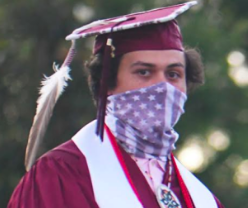Guest Opinion. Education has always been sacred to the Cherokee people. Investing in education was one of the first and highest priorities for Cherokee Nation after the Trail of Tears. Despite the extreme hardships of that time, we quickly established schools in our new land. Within a few years, we had built the first primary schools and institutes of higher education on our reservation.

Our strong commitment to education continues today. Each year, we make substantial donations to school districts in and near our reservation, including a record $7.8 million this year, from tribal car tag revenue. We provide thousands of scholarships to Cherokee students pursuing higher education, and we invest millions in other forms of education like Career Tech and job training.
We do this because, like many Native American nations and people, educating our children is one of our highest values. When Native students complete an educational milestone, like graduating from high school or college, their families often want to celebrate and honor that achievement with a special symbol.
Every year American Indian high school students across Oklahoma, including many Cherokees, are gifted traditional regalia to be worn at graduation ceremonies. Tribal regalia, including items like eagle feathers, jewelry, beaded caps, stoles, moccasins or other symbols, are protected expressions of our cultural and religious beliefs.
For example, an eagle feather symbolizes trust, honor, strength, wisdom, power and freedom. It is a deeply revered object, especially when gifted to mark a significant personal achievement. This can be for leadership or academic accomplishment, as a sign of maturity, and to signify an important educational journey.
These traditions are safeguarded under the Oklahoma Religious Freedom Act. Most schools understand and respect the cultural and legal rights of Native students. Unfortunately, we still see incidents of schools in Oklahoma refusing to allow them.
Cherokee Nation firmly stands behind the rights of Native American students to wear tribal regalia and items of religious or cultural significance during graduation ceremonies. Public schools in Oklahoma must create a safe and inclusive environment where Native American students can freely express their cultural identity without fear of discrimination or punishment. We are proud of our youth, and Cherokees must have the spiritual freedom to show who they are at this important point in their lives.
Cherokee Nation is committed to vigorously defending the rights of Cherokee students, and we call upon all public schools in Oklahoma to clearly state that tribal regalia is allowed for Native American students during graduation ceremonies.

In this, we stand united with other tribes in Oklahoma. The Inter-Tribal Council, representing the Cherokee, Chickasaw, Choctaw, Muscogee and Seminole Nations, passed a resolution calling on public school districts to protect students’ right to wear regalia or other culturally significant items during graduation ceremonies.
Receiving an eagle feather or other tribal regalia for a graduation ceremony can be as significant as earning the diploma itself. These practices honor the graduate and their family, community and tribe. We appreciate the work by our public school districts to ensure that these events are conducted in a safe and respectful manner.
Chuck Hoskin, Jr. is the principal chief of the Cherokee Nation.
More Stories Like This
Governor Stitt, it’s raining. Save SNAP.Remembering My Grandma During Native American Heritage Month
HHS Secretary Kennedy to Indian Country: Even During a Shutdown, Your Health Care is My Priority
Finding the Good News: MacKenzie Scott’s Quiet Commitment Amidst the Noise
Martial Law in an American City —1929
Help us tell the stories that could save Native languages and food traditions
At a critical moment for Indian Country, Native News Online is embarking on our most ambitious reporting project yet: "Cultivating Culture," a three-year investigation into two forces shaping Native community survival—food sovereignty and language revitalization.
The devastating impact of COVID-19 accelerated the loss of Native elders and with them, irreplaceable cultural knowledge. Yet across tribal communities, innovative leaders are fighting back, reclaiming traditional food systems and breathing new life into Native languages. These aren't just cultural preservation efforts—they're powerful pathways to community health, healing, and resilience.
Our dedicated reporting team will spend three years documenting these stories through on-the-ground reporting in 18 tribal communities, producing over 200 in-depth stories, 18 podcast episodes, and multimedia content that amplifies Indigenous voices. We'll show policymakers, funders, and allies how cultural restoration directly impacts physical and mental wellness while celebrating successful models of sovereignty and self-determination.
This isn't corporate media parachuting into Indian Country for a quick story. This is sustained, relationship-based journalism by Native reporters who understand these communities. It's "Warrior Journalism"—fearless reporting that serves the 5.5 million readers who depend on us for news that mainstream media often ignores.
We need your help right now. While we've secured partial funding, we're still $450,000 short of our three-year budget. Our immediate goal is $25,000 this month to keep this critical work moving forward—funding reporter salaries, travel to remote communities, photography, and the deep reporting these stories deserve.
Every dollar directly supports Indigenous journalists telling Indigenous stories. Whether it's $5 or $50, your contribution ensures these vital narratives of resilience, innovation, and hope don't disappear into silence.
 The stakes couldn't be higher. Native languages are being lost at an alarming rate. Food insecurity plagues many tribal communities. But solutions are emerging, and these stories need to be told.
The stakes couldn't be higher. Native languages are being lost at an alarming rate. Food insecurity plagues many tribal communities. But solutions are emerging, and these stories need to be told.
Support independent Native journalism. Fund the stories that matter.
Levi Rickert (Potawatomi), Editor & Publisher
